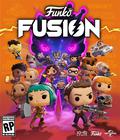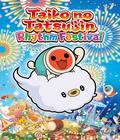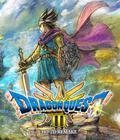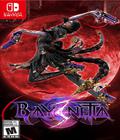Buy Bayonetta 3
It's funny to think about the variety of output from a single game studio. Platinum Games was responsible for what is likely this year's biggest bomb, the already shuttered Babylon's Fall. The very same year, it has also released Bayonetta 3, which is one of the most creative, exciting and fun character action games on the market. It's a surprisingly strong contender for one of the best games of the year. It's not flawless, but it's darn close.
Bayonetta 3 opens with Bayonetta dying. A mysterious figure known only as Singularity is going through the multiverse, destroying world after world by killing their "Arch-Eve," which is almost always a Bayonetta. In this instance, Bayonetta sacrifices herself to give a newcomer witch named Viola a chance to escape to another world. Teaming up the Bayonetta and Jeanne of that world, the trio ventures through the gradually crumbling multiverse, seeking five special items that will allow them to take the fight to Singularity in its home world of The Alphaverse.
My biggest problem with Bayonetta 3 is the story, not because it's kind of nonsense or ridiculous. That was true of the first two games, and they worked just fine. The plot is miserable, like "Avengers: Infinity War." It's pretty much Bayonettas (plural) failing and getting their butts kicked over and over, leading to an incredibly downer ending. Individually, there are a lot of moments with that Bayonetta flair. You visit an alternate dimension where Bayonetta and her mother are French thieves on the run from Inspector Enzo, or there's have a boss fight against Sun Wukong that is framed as a giant bathtub bubble fight. Those moments make the game shine, but then you're back to basically everything being terrible. The game also focuses on a romance subplot that was technically there from the first game but doesn't feel satisfying or earned, and it tries a bit too hard to make itself feel inevitable.
It stands out most with Bayonetta herself. From the start, the game clearly frames her as different from the Bayonetta we knew from the last two games (multiverses and all), but the difference is in the presentation, not the character. She has far less room to quip and is involved in significantly more mercy killing. A lot of the fun from the previous games was Bayonetta being presented as an unflappable, confident and powerful force, and here, she just isn't. I get that it is supposed to show the tension of the situation, but "everything is terrible and the multiverse is collapsing" is so common these days that I'd much rather have seen a dancing witch snark her way through heaven and hell.
Although the story left me cold, the gameplay in Bayonetta is fantastic. The core gameplay is a lot like the last two games in the series, with pretty much every familiar mechanic making a full return. The only significant shift is in how weapons are handled. You no longer equip weapons to hands or legs; you only have two different weapon slots. In exchange, weapons are more of a significant play style change.
There is an absolute boatload of weapons in Bayonetta 3, and it is a delight to see the absurd creations you pick up. There's a giant club that doubles as a railgun, a magician's staff and magical hat that allow you to teleport and summon objects out of thin air, a microphone stand that doubles as a spear and lets you sing for buffs, and even four color-coded lions that attach to your arms and legs and let you be Voltron. Each one feels distinctive, and I am struggling to find one that I favored over the others.
Part of this is also the Demon Masquerade built into each weapon. Previously, Bayonetta could transform into a bird or panther, but each weapon now has an exclusive set of transformations, including different mobility options. Flaming yoyos let you transform into a half-spider, half-woman who can crawl along walls and swing across gaps, in addition to being entirely immune to fire and lava. The microphone-spear transforms you into a partial-frog form that can hop quickly and can't be poisoned. Some let you triple-jump, fly across the sky or launch yourself forward like a bolt. These masquerade forms also replace the previous game's demon summon attacks, with Bayonetta shifting into her monster forms at the end of a combo instead.
New to the game is Viola, who fills the surprisingly busy niche of "young upstart co-protagonist." She takes second billing to Bayonetta in this game, but she has dedicated gameplay mechanics. Much like DMC's Nero, she only has one weapon, a magical katana. The katana can be imbued with fire damage, and it's an all-around good weapon. She can't gain Witch Time by dodging the way Bayonetta can. She has to block, with careful timing rewarding her with the precious slowdown. It changes the way she plays, and muscle memory led me to eat a lot of attacks I probably should've avoided as I adjusted to the big shift in play style. She also unlocks a sort of "Devil Trigger" mechanic, so after she powers up enough, she can transform into an alternate combat form for a short while that is significantly faster and stronger.
Viola is the franchise's Nero to Bayonetta's Dante, and she is a fun character but is badly underutilized. She is effectively Dragon Ball Z's Trunks, except she is a dork who is effective but often the butt of comedy. I enjoy the tone she sets; she reminds me of a cross between Dante and Travis Touchdown, quickly veering between cool and confident and a complete farce. I would've liked to see more of her, but she's basically playable for about three stages, but you can continue to use her in the bonus stages.
The game's big new mechanic is the Demon Slave ability. Obviously borrowing a bit from Astral Chain, the Demon Slave allows you to summon and directly control a demon. You can move the demon around and fight freely, and each demon you equip has its own move set. Madam Butterfly is effectively a giant version of Bayonetta, while Baal is a poisonous singing frog who can slowly build up a screen-clearing super attack by belting out a tune.
The catch is that Demon Slave has limitations. For one thing, Bayonetta can't move while it is in action, leaving her vulnerable, but you can shift back and forth between the two very quickly. It also costs magic meter, which means you can run dry. Demons can also either rampage (sends them temporarily out of control) or be killed (makes them temporarily unavailable). The game also loves to throw other gimmicks at you, so you need to keep your summoning thoughtful, including bosses who can insta-kill a summon that's been kept out too long or a platform that sinks with additional weight.
I was surprised at how well the Demon Slave mechanic worked. Aside from some areas where the camera wasn't quite prepared for a giant lava spider to appear, it felt smooth and easy to shift between the two. Early on, you also get a Wink mechanic. If you press the summon button when Bayonetta flashes after a combo, you'll perform a quick instant-summon attack, and if you time it when an enemy attacks, you'll get a free counter. It gave a nice middle ground between standing still and not summoning at all.
Viola also has access to Demon Slave in a more limited form. She can throw her katana, from which emerges her familiar, Cheshire. Unlike Bayonetta's servants, Cheshire acts of his own free will and attacks as the button is held down. In the meantime, Viola shifts to a bare-knuckle, brawler fighting style that is quite fun. She can still perform the same Wink mechanic as Bayonetta, so you get a little control over Cheshire.
The resulting combat is an chaotic, insane and sensible mess. If you watched a fight, you'd probably have no idea what was going on as Bayonetta shifts constantly between forms; demons appear and disappear; and lasers, bullets and — in one case — a giant train zoom all over the place. Once you get your hands on it, it plays extremely well. Demon Slave is a mechanic that you can use as much or as little as you wish, aside from areas where it is required for a puzzle or an enemy barrier. If you master it, you feel darn powerful.
I'm a bit torn about whether it's the best combat in the series, if only because I preferred the simplicity of the first two games, but it's a damn fine way to take the series in a new direction while keeping the same solid gameplay.
Bayonetta 3 is a lot heavier on the spectacle than the last games. (If you've played the last games, you know that's saying something.) Within the first few chapters, you'll battle enemies on a cruise ship during a tidal wave, travel between multiple dimensions, and summon a giant Godzilla to have a wrestling match with a bizarre goo monster. For a good chunk of the title, there is so much going on that it feels like every stage could be the last stage of another game.
Bayonetta 3 has a heavy helping of minigames that the franchise loves so much. I found most of the minigames to be pretty fun and a lot less distracting than the Space Harrier segments in Bayo1. They're mostly short and funny. There are a couple of times I wish the game had settled on a regular boss fight instead of something weirder, but the game is usually good about exciting boss battles, including a very healthy dose of one-on-one rival fights. I was slightly disappointed by the final boss, who lacks the immense punch of Bayonetta 1 and 2's epic final battles, despite being absolutely absurd on paper.
As usual, there's a lot to do in the game. Almost every stage has an alternate parallel verse that gives you access to challenges to unlock new prizes, including accessories and new weapons. There's a harder difficulty mode and the Witch Trials, remixed fights against multiple enemies that must be done without aid and in a single go. Jeanne also has a weird minigame that plays a bit like Elevator Action and can be played as an arcade game once you've finished the story bits. Most of the fun is going to be trying out different weapons and tougher fights.
Bayonetta 3 is a case where solid art design carries the game a long way. The character models look great, but some of the environmental textures are pretty bad. Even if the title doesn't look as good, it's easy to be drawn in by the sight of a giant, laser-spewing kaiju fight in the middle of a ruined city. The music is phenomenal, with a lot of excellent songs both new and remixed, and I particularly loved the pep-punk styles of Viola's combat themes. If you're following the news at all, you've probably heard about the controversy with Bayonetta's new actress, Jennifer Hale. I can say that Hale does a really good job. She doesn't sound exactly right but close enough that my brain adjusted after a few hours of playing. Weirdly, I think she sounded the most "off" during certain combat cries compared to the cut scenes, which worked well.
Overall, Bayonetta 3 is an incredibly fun game. I like the new mechanics, the new enemies are fun to fight, and it has a lot of laugh-out-loud moments. I just wish all of it wasn't surrounded by a dreary tale of multiversal failure leading into a rather bittersweet ending. If you don't care about the story, the game has few flaws that I can think of. It plays great, is full of amazing absurdity, and was absolutely worth the wait for any fan of the franchise. In the long run, I think Bayonetta 2 is my favorite of the franchise, but Bayonetta 3 is still a remarkably good entry in Platinum's best series.
Score: 9.0/10
More articles about Bayonetta 3











 A new-look Bayonetta returns to battle foes with her signature Witch Time! This time, she’ll wield her new Demon Masquerade ability to channel the power of demons and engage in larger-than-life action.
A new-look Bayonetta returns to battle foes with her signature Witch Time! This time, she’ll wield her new Demon Masquerade ability to channel the power of demons and engage in larger-than-life action.


















































